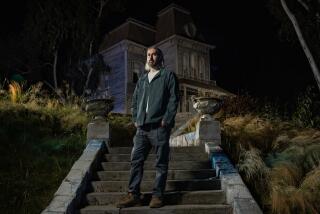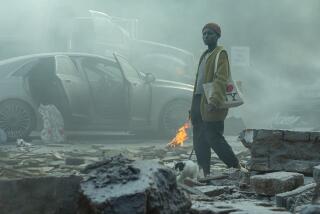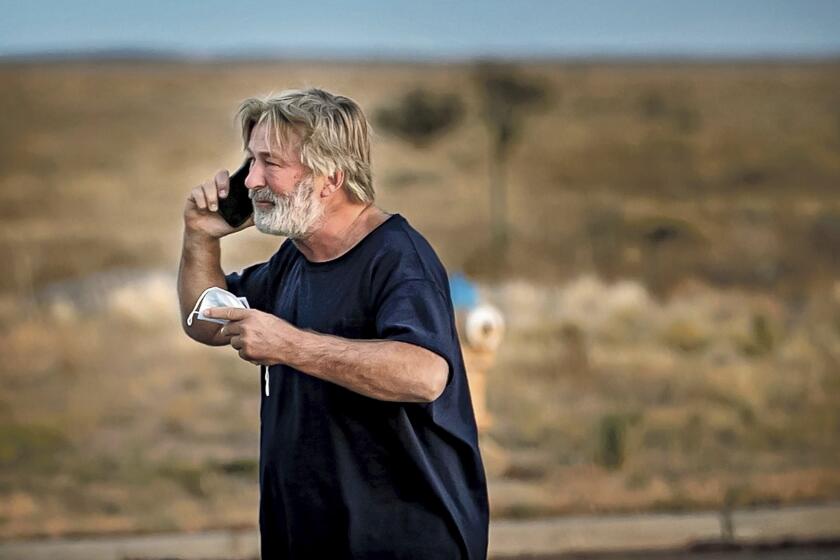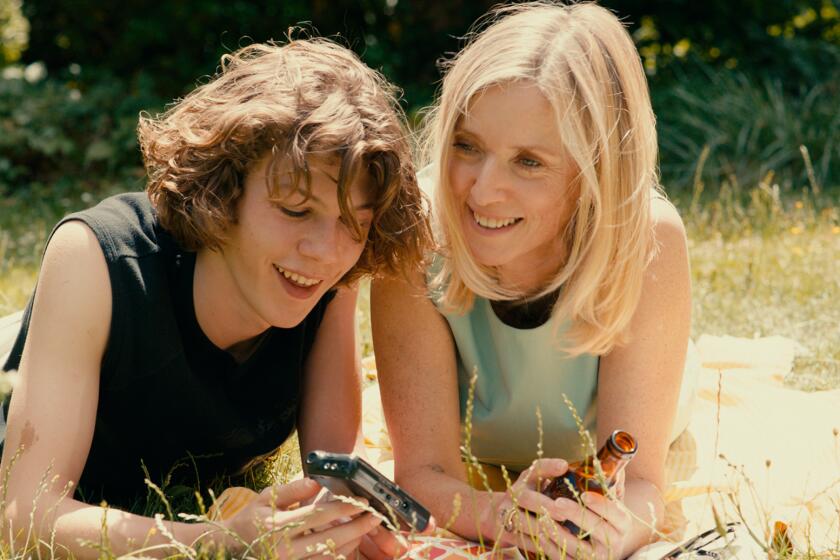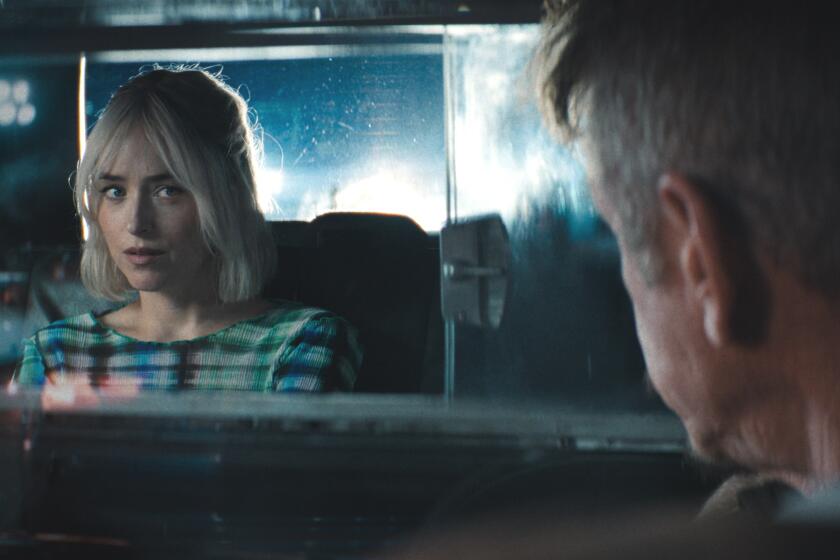Fulfilling a Grand Quest
With an endeavor like “The Lord of the Rings” trilogy, it’s the numbers that catch your eye first--and how could they not? An unprecedented three feature films shot simultaneously in 274 days spread over 15 months at a cost of nearly $300 million are enough to get anyone’s attention. Not to mention 26,000 extras and a special foam latexing oven for baking prosthetic devices--including 1,600 pairs of feet and ears--that ran 24 hours a day, seven days a week, including Christmas and New Year’s Day.
Those figures fascinate but, as directed by Peter Jackson, “The Fellowship of the Ring” makes you forget all about them. Made with intelligence, imagination, passion and skill, propulsively paced and shot through with an aged-in-oak sense of wonder, the trilogy’s first film so thrillingly catches us up in its sweeping story that nothing matters but the vivid and compelling events unfolding on the screen.
What a story it is, overflowing with invention, character and event. Here can be found hairbreadth escapes and heroism in the face of terrifying evil, violent battles and tender sentiments like “I would rather share one lifetime with you than face all the ages of mankind alone.” The basic story line--nine individuals on a desperate quest to save the world--couldn’t be simpler, but the incidents surrounding it, and the very nature of that world, couldn’t be more satisfyingly complex. Which is what J.R.R. Tolkien intended.
An Oxford scholar and a neo-Luddite who never owned a car, Tolkien was a procrastinator and a perfectionist, which is why it took him 14 years to finish his 1,000-plus-page masterwork; a publisher’s edict turned it into a trilogy, a form the author apparently genially detested.
“The Lord of the Rings” is set in Middle-earth, a fantasy world with strong parallels to our own, where striving humans share space with numerous others races, including fierce dwarfs, potent wizards, ethereal elves, 3-foot, 6-inch lovers of creature comforts called hobbits, and several types of evil creatures all owing allegiance to the dread Sauron, the Dark Lord of Mordor.
What’s made Tolkien’s work an overwhelming success with readers since its publication in 1954 is the extraordinary density with which he imagined this world. The “Rings” trilogy comes complete with more than 100 pages of complex appendixes, including maps and detailed genealogies, and Tolkien, a celebrated philologist, invented several complete languages for his characters. The whole idea, the writer said, was for readers “simply to get inside this story and take it in a sense of actual history.”
It is the great triumph of Jackson’s work that he accomplishes this on screen with just as much verve and spirit as Tolkien did on the page--which is not to say that “Fellowship’s” script (by Fran Walsh, Philippa Boyens and Jackson) is an exact copy of the book. Popular characters like Tom Bombadil (described by Wired magazine as a “proto-hippie tree-hugger”) are gone, and the few women in the story have had their roles deftly upgraded.
It’s more that Jackson, a fan of the book for decades, has somehow infused his own unwavering belief into the project. Because “Fellowship” means so much to him, he has brought cast, crew and audience along and done it in a way that pleases devotees yet very much includes people who wouldn’t know a hobbit from a shoe tree.
As director, co-producer and co-writer, Jackson did everything with an eye to serving the story, to enhancing the texture of its reality. That includes having characters speaking in one of the elfish languages when appropriate (with subtitles), using as many as nine individual units to shoot in the remotest and most strangely scenic corners of New Zealand (director Jackson’s home) and doing things like planting, a year before shooting was to begin, 5,000 cubic meters of appropriate vegetation in the part of the country selected to be the hobbits’ home area.
The most important thing Jackson has done, however, is pay attention to character. This is not a psychological drama like Jackson’s earlier triumph, the penetrating “Heavenly Creatures”; its protagonists are unapologetically mythic. But having someone who has an interest in, and insight into, the intricacies of human nature in charge here brings substance and authenticity to the table. It’s the rarest thing to have a director with that kind of perception eager to take on an action-adventure epic with a massive budget, and it makes all the difference.
The “Fellowship” characters are not only drawn acutely, they have been cast with the same shrewdness, even if some choices seemed counterintuitive. Though it is no shock to say that the exceptional Cate Blanchett is excellent as the elf queen Galadriel, it is much more of a pleasant surprise to report that Liv Tyler does some of her best work ever as the elf princess Arwen. And as for the nine actors who do superb ensemble work as the fellowship (Elijah Wood, Ian McKellen, Viggo Mortensen, Sean Astin, John Rhys-Davies, Billy Boyd, Dominic Monaghan, Orlando Bloom and Sean Bean), nothing says more about the close bond they achieved than that they all had themselves tattooed with the No. 9 in one of Tolkien’s invented languages. That includes Sir Ian, the magisterial 62-year-old known for his superb interpretations of Shakespeare.
As the hobbit Frodo, Wood may be the heart of the quest, Mortensen as the human Aragorn may be brooding and electric on screen, but it is McKellen as the wizard Gandalf who is the film’s irreplaceable central figure. Radiating power and wisdom, tossing out piercing looks as deftly as he wields his magical staff, McKellen’s exceptional presence makes the actuality of “Fellowship” unassailable. To see the man who was the fey James Whale in “Gods and Monsters” in full battle mode against the forces of evil is to understand what a great actor can accomplish.
“Fellowship” begins with Gandalf’s visit to the hobbit Bilbo Baggins (a charming Ian Holm), an old friend who is having a birthday. Bilbo has had a magic ring in his possession for many years, and Gandalf reveals to him (and us) its terrifying history. It was a ring of power forged by the dark lord Sauron with the capacity to enslave all the free peoples of Middle-earth (hence the line, “one ring to rule them all”). Although no longer in Sauron’s possession, it is a ring with a mind of its own, always eager to get back to its dread creator, who is now actively searching for it as well.
Just a thin gold band, it has an almost limitless ability to corrupt. Gandalf insists that Bilbo give the ring to his nephew Frodo while he goes off to consult with another powerful wizard, Saruman the White (British horror veteran Christopher Lee). At a meeting in the land of the elf Elrond (Hugo Weaving), it is determined that for Middle-earth to survive the ring must be returned to the fires of the distant and perilous Mount Doom--where it was forged--and destroyed. Frodo is to be the ring bearer, and he’s accompanied on his terrible journey not only by Gandalf and Aragorn, but also his hobbit friends Sam (Astin), Pippin (Boyd) and Merry (Monaghan), the all too human Boromir (Bean), the cool elf Legolas (Bloom) and the fierce dwarf Gimli (Rhys-Davies). So is born the Fellowship of the Ring, whose adventures, set to Howard Shore’s stirring music, we avidly follow.
The care taken with even the smallest detail by Jackson’s production team makes all this seem surprisingly realistic. Conceptual artists and Tolkien illustrators Alan Lee and John Howe, cinematographer Andrew Lesnie, production designer Grant Major, editor John Gilbert, costume designer Ngila Dickson, effects wizards Richard Taylor and Jim Rygiel and others too numerous to mention all deserve to take a bow.
Interestingly enough, many of the film’s special effects don’t rely on computers. Expert use was made of more than 60 intricately constructed miniatures, as well as of forced perspective, a venerable way to fool the eye by means of the shrewd employment of camera angles and stand-ins of different heights. When computers were used, it was the New Zealand-based Weta Digital that did them. Their look is a bit rougher and less polished than we’re used to from domestic companies such as ILM, but it’s a style that suits this rough-and-ready film.
Though “The Fellowship of the Ring” is an impressive 2 hours and 58 minutes long, its sense of adventure never flags, with one peril leading naturally to the next. The film’s only real drawback, in fact, is that it will be a full year until the next installment, “The Two Towers,” is allowed on screen. Some of us are already counting the days.
*
MPAA rating: PG-13, for epic battle sequences and some scary images. Times guidelines: The action gets fairly intense, including a few beheadings, and some nightmarish monsters.
‘Lord of the Rings: The Fellowship of the Ring’
Elijah Wood ... Frodo Baggins
Ian McKellen ... Gandalf
Liv Tyler ... Arwen
Viggo Mortensen ... Aragorn
Sean Astin ... Sam
Cate Blanchett ... Galadriel
John Rhys-Davies ... Gimli
Billy Boyd ... Pippin
Dominic Monaghan ... Merry
Orlando Bloom ... Legolas
Christopher Lee ... Saruman
Hugo Weaving ... Elrond
Sean Bean ... Boromir
Ian Holm ... Bilbo Baggins
Andy Serkis ... Gollum
A Wingnut Films production, released by New Line Cinema. Director Peter Jackson. Producers Barrie M. Osborne, Peter Jackson, Fran Walsh, Tim Sanders. Executive producers Mark Ordesky, Bob Weinstein, Harvey Weinstein, Robert Shaye, Michael Lynne. Screenplay Fran Walsh & Philippa Boyens & Peter Jackson, based on the book by J.R.R. Tolkien. Cinematographer Andrew Lesnie. Editor John Gilbert. Costumes Ngila Dickson, Richard Taylor. Music Howard Shore. Production design Grant Major. Art directors (Peter) Joe Bleakley, Rob Otterside, Phil Ivey, Mark Robins. Set decorator Dan Hennah. Running time: 2 hours, 58 minutes.
In general release.
More to Read
Only good movies
Get the Indie Focus newsletter, Mark Olsen's weekly guide to the world of cinema.
You may occasionally receive promotional content from the Los Angeles Times.
